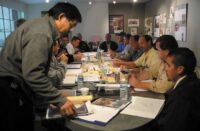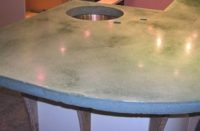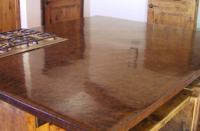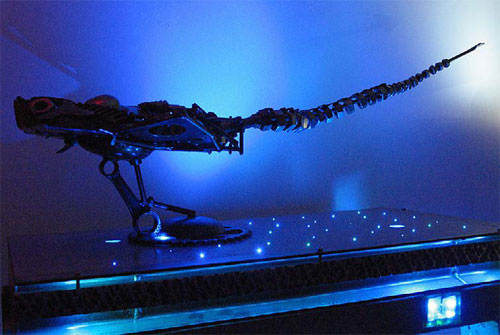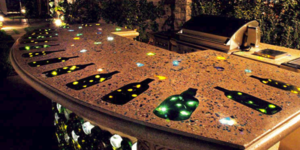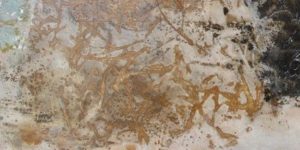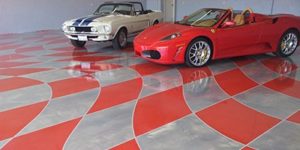There are few things you can add to decorative concrete that are as impactful – or as unpredictable – as light. Just like water, light is a natural entity with subtleties and effects that unfold in unexpected ways. Light can create an environment without help from structure, shape or texture.
However, because there are so many variables with light, a concrete artisan needs to experiment and practice with lighting effects beyond just taking a class or watching a demonstration. Embedded lighting in countertops looks different depending on the time of day, other light (natural or man-made) in the room, even the vantage point of people walking by. So when you’re working with light, it helps to have experience in different settings. It also helps to take a project in small steps, adding or changing some light effects as the design progresses.
Since we are all cave dwellers attracted to flickering flame and dancing shadows on cave walls, lighting will always offer a great deal of substance in the design of any space.
Maybe for example, you can use an inexpensive motion sensor to turn on an illuminator below a cabinet, so fiber optics in a bathroom vanity become a child’s night light. Light makes many products more appealing, prominent or functional – think of signage, the front of a home, or any space void of structure.
So, how can you use light to create the environment your client wants in a concrete countertop, bar or wall? Let’s look at the basics of the technology and new developments in light sources.
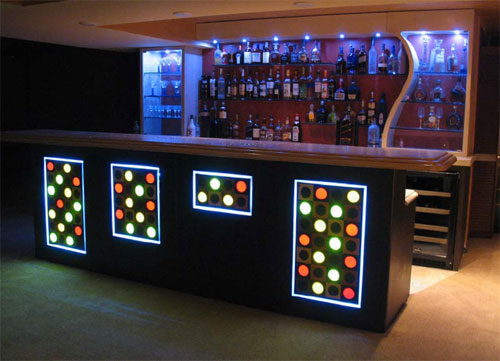
Fiber optics
Optical fibers are not actually a light source – you can’t just plug them in and turn them on. What they really are is a conduit that carries light from a remote source, an illuminator, at one end to a predetermined exit point in a counter or panel at the other end. Traditional illuminators are metal halide or halogen bulbs, but optical fibers will carry light from any source.
For example, one prominent architect created a dynamic environment by directing bright light at the floor. The light is carried along embedded optical fibers in the floor tiles to a wall. When someone walks over the tiles, the light is interrupted, so the person’s movement is tracked along the wall.
In a more traditional installation, light from the illuminator can be interrupted to create a dynamic pattern such as a fire-burst. An opaque wheel with openings or holes turns in front of the light. The hole pattern is cut according to calculations of which fibers need to be lit and for how long in order to create a desired effect. Calculating the pattern and cutting the holes is quite tedious and costly.
Advances in light-emitting diode (LED) light sources that can be programmed by computer have made creating moving light shows much simpler and less costly.
Optical fibers are colorless, so color can only be added by changing the color of the light source or at the end. Embedding colored glass or acrylic at the fibers’ terminus will result in points of colored light. You can create patterns with colored light in countertops by using different colors of glass or acrylic.
Another way to create color is to insert a color film between the light source and the fiber. A color wheel changes the colors in a set pattern. Again, programmable LED light sources give concrete artisans and their customers much more flexibility and control than traditional bulbs and color wheels.
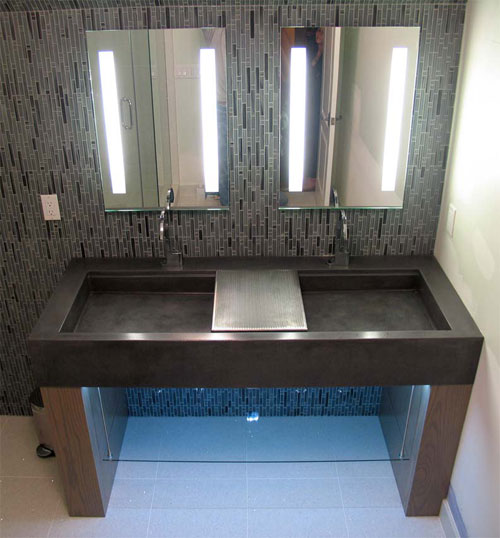
LEDing the way
Besides improving old effects, LED illuminators for fiber-optic projects give designers many options not available with standard light sources.
LED light sources for fiber optics are available in white or in standard RGB (red-green-blue) that can be programmed to create whatever color or colors the customer wants. You can even program how long a color or light will display, or the lights can strobe or dim.
LED lights are very versatile. They require little energy and produce little heat, so it is easier to place them as a source for fiber-optic systems. LED illuminators are getting brighter, so they are capable of lighting side-emitting optical fibers that emit light evenly along the whole length of the fiber, not just at the end. Even these brighter LED illuminators still use less energy and produce less heat than metal halide or halogen, and they last longer.
LEDs increase the possibilities for fiber optics, but the results are still limited by the fibers themselves. Optical fibers are great for focusing pinpoints of light, but that pixilated look is not always the effect you want. Happily, a number of products based on LED technology have vastly expanded the options available to concrete artisans.
For example, a rope of LED bulbs behind a panel of acrylic, frosted glass or concrete with pieces of colored glass set into it creates even backlighting without hot spots. A rope like this can’t change color, so choose the color you want or use different colors of glass for white light to shine through. A rope light will last only a couple of years, so plan access accordingly.
Another type of LED is a cove light – a square “rope” of large-aperture LEDs that shine light in a wide angle instead of at one hot point.
Now LED technology is getting even smaller and more versatile. There are LED films and tapes with tiny LED lights on them that can go almost anywhere. Washes of light from LEDs accent textures and curves cast into your medium. Use them to light panels on the front of a bar or architectural reveals at the floor transition or to halo the perimeter of tables or other furniture. Low-profile tapes, strips and ropes completely change how your concrete product is viewed.
It is possible to get corny or over-the-top with these effects – testing, using, playing with these components is a learning process. Working with light is trial-and-error and sometimes the outcome is a guess. Only through experience will you learn to outline the expectations of how the finished product will look. Experimenting with and understanding the possibilities of lighting puts you a step above a simple fabricator who is assembling a bare countertop.
Getting LED-Crazy on One Project
An imaginary project illustrates all the effects you could create using the fiber optic and LED capabilities described in this article.
Say your customer wants a bar that will really make a splash. What could you do with a bar – 30 feet long, square return, 42 inches high – in a large open room with a great view of the front face
You can tell the owner: “I see making panels in front of this bar in an architectural finish that will wear well. It will create a great visual for people when you do your catering in this open space, and it will provide ambience lighting when people are at the bar. How about we make square panels 3/4 inch thick and cast in a design of hop branches in a sandy, golden color? If we set round glass beads in the panel to let light through the back to the front, they will look like bubbles in the beer when they are illuminated. We will put an LED rope coil behind the panel which will put a halo of light around it, and the glass will allow the light to transmit through.”
The owner might question whether all that backlighting will prevent guests from seeing the concrete detail from the front. Your answer? “We can use this low-profile cove light LED that, unlike rope light, will directionally cast a beam of light across the face without taking away from the halo or the beads.”
Even fiber optics have a place in this fantasy design. “Let’s cut beer steins in slices and use fiber optic pinpoints to make it look like there are foaming heads of lights in the embedded steins. To make sure the light is strong enough through this dark glass we might have to create some mock-ups.”
This bar may exist only on paper for now, but my experience is that creating a spectacle like this draws so much attention that it pays for itself in increased business. If you are excited and confident, the owner will get excited too by all the possibilities of concrete and light.
